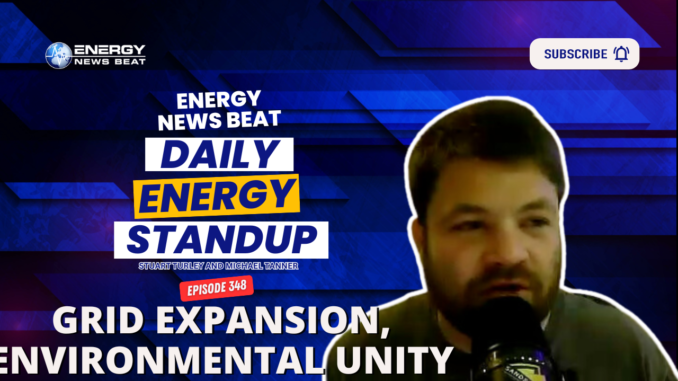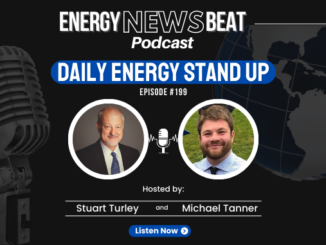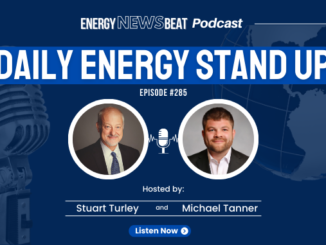
Daily Standup Top Stories
The U.S. Urgently Needs a Bigger Grid. Here’s a Fast Solution.
One of the biggest obstacles to expanding clean energy in the United States is a lack of power lines. Building new transmission lines can take a decade or more because of permitting delays and local […]
Pipeline company, environmental group strike unique ‘community benefits’ agreement
LINCOLN — The developer of a carbon-dioxide pipeline and an environmental group have struck a “one-of-a-kind” agreement to ensure “community benefits” from the pipeline as well as support for the project. While similar CO2 pipeline […]
Highlights of the Podcast
00:00 – Intro
01:08 – The U.S. Urgently Needs a Bigger Grid. Here’s a Fast Solution.
04:56 – Pipeline company, environmental group strike unique ‘community benefits’ agreement
08:24 – Markets Update
11:31 – Outro
Follow Stuart On LinkedIn and Twitter
Follow Michael On LinkedIn and Twitter
– Get in Contact With The Show –
Video Transcription edited for grammar. We disavow any errors unless they make us look better or smarter.
Michael Tanner: [00:00:14] What’s going on, everybody? Welcome into the Wednesday, April 10th, 2024 edition of the Daily Energy News Beat stand up. Here are today’s top headlines. First up, the U.S. urgently needs a bigger grid. Here’s a fast solution. Next up in a short news segment. Pipeline company. Environmental group. Strike. Quote. Unique benefit agreement is an absolutely interesting story. I will then toss it to myself and quickly cover what’s going on in the oil and gas finance markets, followed by a little bit what’s, what we saw with the API, forecasting what you will hear the EIA reports for crude oil inventories. I will cover all that and a bag of chips, guys here on a solo show today, as always, I am Michael Tanner. Stu is out on assignment. So as always, I will hold the fort down. [00:01:07][52.9]
Michael Tanner: [00:01:08] Let’s go and kick us off, though. First for story, I wanted to cover the U.S. urgently needs a bigger grid. Here’s a fast solution. You know, one of the biggest obstacles to expanding clean energy in the United States is our massive lack of power lines. Building these new transmission lines can take basically more than a decade. It’s absolutely unbelievable. But according to a recent report released Tuesday, they’re actually use a cheaper solution. You can actually go in and replace these existing power lines with, quote, state of the art materials that could roughly double the capacity of the electric grid in many parts of the country, making room for much more electrical capacity. This technique, and I’m reading directly from the article right now, this technique, known as advanced re conductor, is actually widely used in other countries, but many U.S. utilities have been slow to embrace it because of their unfamiliarity with the technology, as well as the regulatory and bureaucratic hurdles, according to the research. This is unbelievable. So this is a senior Simon quoting now a senior scientist, Amol Radack. He’s out of the University of California, Berkeley, who said we were pretty astonished at how big of an increased capacity you can get by re conductor rig it. Actually he scores. He goes on to say, quote, it’s not the only thing we need to do is upgrade the it’s not the only thing we need to upgrade the grid, but it can be a major part of the solution. What’s crazy, though, is that this has already been proven not only around the country, but in the United States. So in 2011, AEP, a utility in Texas, urgently needed to deliver. And again, I’m reading directly from the article, urgently needed to deliver more power to the Rio Grande of the lower Rio Grande Valley to meet soaring population growth. It would have taken too long to acquire land and permits to build towers for new transmission lines. Instead, they turned to this refactoring idea and replaced about 240 miles of existing line with these advanced conductors. It took less than three years and increase the capacity carrying capacity of the lines by over 40%, which is unbelievable for you wind and solar junkies out there. You should all be for advanced conductor because it can absolutely do exactly that. So why hasn’t this really happened yet? Well, there’s an interesting article, or part of this article where basically it says, you know, the incentives are also a little bit mismatched. I’m gonna go back to reading straight from the article now. Because of the way in which utilities are compensated, they often have more financial incentives to build new lines rather than upgrading existing equipment. Well that’s sweet. I’m glad that’s the incentive so that we can have a suboptimal grid. That’s great to know. Conversely, now back reading from the article. Conversely, some regulators are wary of the higher upfront cost of advanced conductors, even if they pay out for themselves in the long run. Many utilities have also little motivation to cooperate with one another on long term transmission planning. And that comes back to the fact that the United States is run on three grids by over 3200 different utilities and a massively complex patchwork network of regional planners and regulators. So trying to get anybody on the same consensus is super tough. But if those are the only two things holding us back from a better grid, we already knew this. We’re idiots though. We’ve got to. Yeah, I was reading this article like we’ve it’s already here. The text proven we’ve already actually used this in Texas. It’s unbelievable folks. It makes you think they don’t want the grid to get better. It makes you pause and think, do they actually want to make the grid better or do they want to? Or what do they want to do? I don’t either, I won’t even speculate on what they want to do. The point is, I have a feeling they’re either dumb, they’re not dumb. So which means they must know. And it means they’re there’s other quote unquote mismatched incentives. So absolutely crazy article guys. We can have a bigger grid. [00:04:56][227.5]
Michael Tanner: [00:04:56] Let’s move to the next one here. Pipeline company environmental group strike unique community benefits agreement. Super interesting here. A developer of a carbon dioxide pipeline, pipeline and environmental group have struck a, quote, one of a. Find agreement to ensure, quote, community benefits from a pipeline as well as support for the project. Interesting. So this is a CO2 pipeline project, that’s running through Nebraska right now. Kansas based tallgrass is converting a 392 mile long natural gas pipeline to transport CO2, according to the announcement Tuesday, with agreement from Bold Alliance, the subsidiary of Bold Nebraska, one of the leading opponents of the Keystone XL crude oil pipeline. College grass is converting the trailblazer pipeline, which runs from Beatrice, Nebraska, to eastern Wyoming, to carry carbon dioxide generated by ethanol plants. Proceed quest station deep underground in Wyoming. The goal is to meet the demand for less carbon intensive biofuels in states seeking environ mental benefits. I have mixed feelings on this, and I think it’s great that we’re getting buy in from the environmental crowd. I do think we need to look at carbon emissions and do some of this stuff. I do think sequestration is going to become a thing, but what is this pipeline producing if this pipeline wasn’t producing, which I’m not sure if it is, because they’re going to converting it into CO2. Well, that’s or could they not continue to operate the natural gas pipeline because of this, this bold Nebraska and Bold Alliance thing? I don’t necessarily know. The article doesn’t necessarily say so. I don’t want to speculate. However, though it’s going to be super, super interesting to see how this goes forward. If all of a sudden now these alliances are going to be strong arming pipeline companies to convert existing infrastructure into CO2 pipelines, where and this is me from a finance I don’t know how you make money on carbon sequestration. Is it the carbon credits? Is it we’re transporting all this CO2. So now we’re going to go ahead and get all of the specific carbon credits associated with it. I don’t I don’t actually know. All I know is tallgrass, according to these bold, Alliance folks, is the first pipeline company that’s been willing to engage proactively acknowledging the needs for land owner benefits, and generally committed to addressing benefits in a written leak. A lot of this comes down to, some eminent domain issues that going go on with some of the extensions of this pipeline. But folks, the it’s really interesting to see what’s going on here. And in terms of of where the CO2 sequestration stuff goes, we will make sure to keep you guys abreast there. [00:07:39][162.4]
Michael Tanner: [00:07:39] Before I move into the finance section. I just want to quickly pay the bills here, guys. As always, the news and quote unquote analysis you just heard is brought to you by the world’s greatest website, www.EnergyNewsBeat.com The best place for all your energy and oil and gas news. This team do a tremendous job making sure that website stays up to speed. Everything you need to know. Be the tip of the spear when it comes to the energy in the oil and gas business. Check out the description below for all links and timestamps to the article. If you’re on Spotify, you can hit the chapters very easily. We’re working on a solution, for iTunes at the moment. Check us out on YouTube. You can also check us out. Dashboard.energynewsbeat.com The best place for all your data and energy news combo. Again www.energynewsbeat.com. [00:08:22][43.1]
Michael Tanner: [00:08:24] But let’s go ahead and move into finance. Will we see overall market’s fairly flat today. We’re only up about 510 or about one tenth of a percentage point. Nasdaq was up about 4/10 of a percentage point. We saw two and ten year yields fairly flat with ten year yields actually down about a 10th of a percentage point dollar index fairly flat. We see Bitcoin down three and a half percentage points currently trading just below 70,000. They’re at 69,130 for crude oil has itself a little bit of a down day. We were down about 1.3 percentage points off yesterday’s high crude oil. WTI currently sitting at 8523. Brant oil down only about a half a percentage point currently sitting at 8961 natural gas pops a little bit 1.5 percentage points currently sitting at $1.87. I think the the interesting thing to note about crude oil prices is this comes after the second day of talks for a ceasefire in Gaza. There really is an interesting conundrum. It was these talks held in Cairo, which ironically, the U. The CIA was there. So who knows if those talks. I’m I’m just reading the article. Apparently it talks in Cairo, and they went out to point out that the director of the CIA was there. And of course, so, so far they failed to reach a breakthrough, of course, because which is the CIA. Now I’m I’m sounding a little bit like, stupid. You’d be proud of me for for bringing up some sort of conspiracy. But the point is this cease fire now, between, Hamas and Israel seems maybe a little bit more likely part of, again, what was baked into where prices was going was that geopolitical risk. Now, I think what we’re going to see is maybe some of these tensions continue to die down. Who knows? Things could turn on a dime. We’re now going to go back to the question and. We talked. I talked about this yesterday on the show, the short squeeze that Russia, Saudi and OPEC is really doing, I think, on the Biden administration to squeeze oil prices higher. They’ve been helped and buoyed by some of the geopolitical tension in the Middle East. If you turn and dial that back down a little bit, is there does that mean more cuts coming out of OPEC? Does that mean that they’re going to continue and Russia is going to be slow to bring on a lot of this, a lot of this refining capacity? I don’t know the answer to that, but it’s looking awfully like a short squeeze. And if they’re going to continue to squeeze oil prices to the point where it makes it vastly uncomfortable, for the American people here at home, come election time, they’re going to need to do something. If these tensions continue to win, wind down. So I think it’s an interesting dynamic. You will see today the EIA crude oil inventory number. The API estimates a 3.3 million barrel or 3.03 million barrel build in the Strategic Petroleum Reserve. So that number may or may not be confirmed. Last month, or last week, I should say we were we were estimating a 2.2 million barrel build when that, that our draw date actually came in at a build on the EIA side. So now this week they could reverse and estimate a build. We’ll see what this stuff says. [00:11:30][185.6]
Michael Tanner: [00:11:31] It’s really all I got guys. you will see we we didn’t get the deal spotlight out today yesterday. We’re going to get that out here today so you can listen to that. Me and John Ferrell break down everything that’s going on with the port Plus deal. But just check us out, guys. Appreciate everybody tuning in. And, with that, I’ll let you guys get out of here. We’ll see you tomorrow. [00:11:31][0.0][671.5]
– Get in Contact With The Show –



